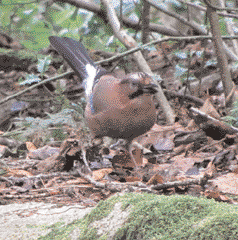|
Wildlife
Newsletter for the Township of Dalkey March 2013 - Michael Ryan |
| March
is the month our first early avian migrants start to arrive with sightings
of Wheatears and Sand Martins almost guaranteed in the first couple
of weeks. Favourable southerly winds can help the birds move north quickly
while strong northerly winds will delay their arrival. Our resident
birds will be nesting soon as well so please be careful if cutting hedges,
bushes or ivy. On a dull, cool morning our ninety minute meander around
the hills produced no interesting wildlife apart from a solitary raven
croaking its way across the sky. Not a squirrel to be seen, it was probably
the strong wind that kept them curled up in their nest boxes. They weren’t
going to be jumping from tree to tree if the branches were swaying around.
Before the reintroduced squirrels were retrapped to have their radio
collars removed a few had already lost theirs. Anuisance for the researchers
who weren’t then able to trace their whereabouts by the radio
signals. They deduced later what might have caused the loss of the collars. Some
of the reintroduced reds were actually sharing nestboxes at night and
they think they may well have chewed through each others collars for
reasons best known themselves. |
|
|
|
|
 Killiney Jay |
I
always look forward to training the telescope on to the reeds in the
north east corner and possibly picking out a snipe or two sitting almost
motionless in the morning light. They have a gentle, elegant appearance
with big soft eyes at the base of a long bill. Sadly their zigzagging
flight when alarmed has made them a favourite target for wildfowlers
and the shooting of these harmless creatures has brought the term sniper
into the language. Our February count had an early start but at least
the weather forecast was promising long dry spells. When we all met
at our starting point we all commented on the irony of this as we stood
in the driving rain which proceeded to get worse as the morning went
on. Anyhow we got the count on the strand done and went up the railway bridge to get a good view into the marsh, getting some shelter from the drizzle that was fogging up our ‘scope lens. A quick look at the corner revealed a few snipe sitting in the open, well out from the reeds. Then scanning across the reeds revealed the biggest group of snipe I’d ever seen together, almost thirty of them. Other little groups became visible grouped around the edge of the reed. |
As
we counted a total of 62 and there’s every chance there were more
hidden in the grasses. We’d had up to twenty of them in the marsh
before on counts but this was far more snipe then I’d ever seen
and I’m sure a record for the marsh. Snipe feed by pushing their
long bill into soft mud so if the ground is frozen they’re in
trouble. Maybe the cold weather had brought birds from inland or from
Britain but whatever reason brought them I wasdelighted to see them.
Between a busy main road and a busy railway line within a few miles of a city centre it’s a real privilege to see these birds that are more usually associated with remote wetlands and bogs. When they move to their breeding territory the male bird will do a display which includes a diving flight that produces a strange sound often compared to the bleating of a goat. The noise is made by two small feathers which protrude stiffly out of the wing creating a vibration as the wind rushes past and making the noise that had previously given them the evocative names of Bog Bleater and She-goat of the Air. |